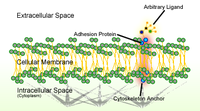
Photo from wikipedia
Recognised as one of the hallmarks of cancer, local cancer cell invasion is a complex multiscale process that combines the secretion of matrix-degrading enzymes with a series of altered key… Click to show full abstract
Recognised as one of the hallmarks of cancer, local cancer cell invasion is a complex multiscale process that combines the secretion of matrix-degrading enzymes with a series of altered key cell processes (such as abnormal cell proliferation and changes in cell–cell and cell–matrix adhesion leading to enhanced migration) to degrade important components of the surrounding extracellular matrix (ECM) and this way spread further in the human tissue. In order to gain a deeper understanding of the invasion process, we pay special attention to the interacting dynamics between the cancer cell population and various constituents of the surrounding tumour microenvironment. To that end, we consider the key role that ECM plays within the human body tissue, and in particular we focus on the special contribution of its fibrous proteins components, such as collagen and fibronectin, which play an important part in cell proliferation and migration. In this work, we consider the two-scale dynamic cross-talk between cancer cells and a two-component ECM (consisting of both a fibre and a non-fibre phase). To that end, we incorporate the interlinked two-scale dynamics of cell–ECM interactions within the tumour support that contributes simultaneously both to cell adhesion and to the dynamic rearrangement and restructuring of the ECM fibres. Furthermore, this is embedded within a multiscale moving boundary approach for the invading cancer cell population, in the presence of cell adhesion at the tissue scale and cell-scale fibre redistribution activity and leading edge matrix-degrading enzyme molecular proteolytic processes. The overall modelling framework will be accompanied by computational results that will explore the impact on cancer invasion patterns of different levels of cell adhesion in conjunction with the continuous ECM fibres rearrangement.
Journal Title: Bulletin of Mathematical Biology
Year Published: 2019
Link to full text (if available)
Share on Social Media: Sign Up to like & get
recommendations!